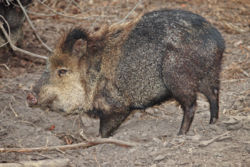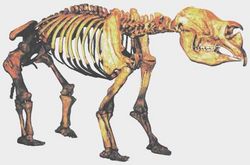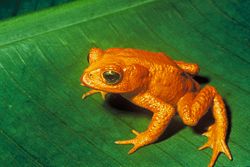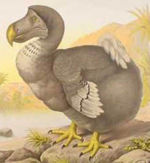From Wikipedia, the free encyclopedia
| The Dodo, a bird of Mauritius, became extinct during the mid-late seventeenth century after humans destroyed the forests where the birds made their homes and introduced animals that ate their eggs. |
Contents[hide] |
[edit] The prehistoric extinction events
The ongoing extinction event seems more outstanding if we follow tradition and separate the recent extinction (approximately since the industrial revolution) from the Pleistocene extinction near the end of the last ice age. The latter is exemplified by the extinction of the woolly mammoth and, incorrectly, the Neanderthal people.
However, modern climatology suggests the current Holocene epoch is no more than the latest in a series of interglacial intervals. Furthermore, there is a continuum of extinctions between 13,000 years ago and now. If only considering human impact, the vulnerability and extinction rate of species simply rises with the increase in human population, so there would be no need to separate the Pleistocene extinction from the recent one. Nevertheless, the Pleistocene extinction event is large enough and has not been resolved completely.
[edit] The Pleistocene or Ice Age extinction event
The Ice Age extinction event is characterised by the extinction of many large mammals weighing more than 40 kg. In North America around 33 of 45 genera of large mammals became extinct, in South America 46 of 58, in Australia 15 of 16, in Europe 7 of 23, and in Subsaharan Africa only 2 of 44. The South American extinction witnessed the aftermath of the Great American Interchange. Only in South America and Australia did the extinction occur at family taxonomic levels or higher.
There are two main hypotheses concerning the Pleistocene extinction:
- The animals died off due to climate change: the retreat of the polar ice cap.
- The animals were exterminated by humans: the "prehistoric overkill hypothesis" (Martin, 1967).
The prehistoric overkill hypothesis is not universally applicable and is imperfectly confirmed. For instance, there are ambiguities around the timing of sudden extinctions of marsupial Australian megafauna. Biologists note that comparable extinctions have not occurred in Africa, where the fauna evolved with hominids. Post-glacial megafaunal extinctions in Africa have been spaced over a longer interval.
An alternative to the theory of human responsibility is Alexander Tollmann's bolide theory, a more controversial hypothesis which claims that the Holocene was initiated by an extinction event caused by bolide impacts.
[edit] Major megafaunal extinctions
[edit] Europe
(circa 15,000 years ago)
[edit] Mediterranean Islands
(by 9000 years ago)
- a pygmy hippopotamus, the Cyprus dwarf hippopotamus (Phanourios minutus) of Cyprus
- the Balearic Islands cave goat (Myotragus balearicus) of Majorca and Minorca
- Dwarf elephants: Elephas cypriotes of Cyprus, E. falconeri of Sicily and Malta
- Giant swan (Cygnus falconeri) of Malta
- Giant rat of Majorca

[edit] North America
During the last 50 thousand years, including the end of the last ice age, approximately 33 genera of large mammals have become extinct in North America. Of these, 15 genera extinctions can be reliably attributed to a brief interval of 11.5 to 10 thousand radiocarbon years before present, shortly following the arrival of the Clovis people in North America. Most other extinctions are poorly constrained in time, though some definitely occurred outside of this narrow interval.[3] Contrary to this, only about half a dozen small mammals disappeared during this time. Previous North American extinction pulses had occurred at the end of glaciations, but not with such an imbalance between large mammals and small ones. The megafaunal extinctions include twelve genera of edible herbivores (H), and five large, dangerous carnivores (C). North American extinctions included
- American horses, five species (Asian horses survived) (H)
- a few species of Western Camels (H)
- North American llamas (H)
- Deer, two genera (H)
- Pronghorn, two genera (one survived) (H)
- Stag-moose, Shrub-oxen, Woodland muskoxen (an Arctic one survived) (H)
- Giant Beaver
- Shasta Ground sloth and other Ground sloths
- Short-faced bears (larger than the present Grizzly Bear), cf Cave bear (C)
- Saber-toothed cats (C)
- American lion (larger than the current African Lion but probably a fairly recent immigrant through Beringia) (C)
- American cheetah (C)
- Dire wolf (C)
- Mammoth, several species
- American mastodon, Mammut americanum
- The giant progenitor sub-species of the surviving bison
- Giant peccary
- California tapir (H)
The survivors are as significant as the losses: bison, moose (recent immigrants through Beringia), elk, caribou, deer, pronghorn, muskox, bighorn sheep, mountain goat. All save the pronghorns descended from Asian ancestors that had evolved human predators.[4]
The culture that has been connected with the wave of extinctions in North America is the paleo-Indian culture associated with the Clovis people (q.v.), who were thought to use spear throwers to kill large animals. The chief opposition to the "prehistoric overkill hypothesis" has been that population of humans such as the Clovis culture were too small to be ecologically significant. Other generalized evocations of climate change fail under detailed scrutiny.
Lack of tameable megafauna was one of the reasons why Amerindian civilizations evolved differently than Old World ones.[5] Critics have disputed this by arguing that llama, vicuña, and bison were domesticated[6]
[edit] South America
In South America, which had remained largely unglaciated except for increased mountain glaciation in the Andes, there was a contemporaneous but smaller wave of extinctions.
[edit] Australia

The sudden spate of extinctions came earlier than in the Americas. Most evidence points to the period immediately after the first arrival of humans — thought to be a little under 50,000 years ago — but scientific argument continues as to the exact date range. The Australian extinctions included:
- diprotodons (giant relatives of the wombats)
- Zygomaturus trilobus (a large marsupial herbivore)
- Palorchestes azael (a marsupial "tapir")
- Macropus titan (a giant kangaroo)
- Procoptodon goliah (a hoof-toed giant short-faced kangaroo)
- Wonambi naracoortensis (a five-to-six-metre-long Australian constrictor snake)
- Thylacoleo carnifex (a lioness-sized marsupial carnivore)
- Megalania prisca (a giant monitor lizard)
Some extinct megafauna, such as the bunyip-like diprotodon, may be the sources of ancient cryptozoological legends.
[edit] Younger extinctions
[edit] New Zealand
c. AD 1500, several species became extinct after Polynesian settlers arrived, including:
- Ten species of Moa, giant flightless ratite birds.
- The giant Haast's Eagle, Harpagornis
- The flightless predatory Adzebills.
[edit] Pacific, including Hawaii
Recent research, based on archaeological and paleontological digs on 70 different islands, has shown that numerous species went extinct as people moved across the Pacific, starting 30,000 years ago in the Bismarck Archipelago and Solomon Islands (Steadman & Martin 2003). It is currently estimated that among the bird species of the Pacific some 2000 species have gone extinct since the arrivial of humans (Steadman 1995). Among the extinctions were:
- The Moa-nalos, giant grazing ducks from Hawaii.
- A giant megapode from New Caledonia.
- Mekosuchine crocodiles from New Caledonia, Fiji and Samoa.
[edit] Madagascar
Starting with the arrival of humans c. 2000 years ago, nearly all of the island's megafauna became extinct, including:
- the Aepyornis, or Elephant Bird, a giant flightless ratite bird.
- 17 of 50 species of lemur, including:
- giant aye-aye (Daubentonia robusta); last known individual killed 1930
- sloth lemurs, including chimpanzee-sized Palaeopropithecus and gorilla-sized Archaeoindris
- Megaladapis, an orangutan-sized arboreal lemur
- giant tortoise
- pygmy hippopotamus
[edit] Indian Ocean Islands
Starting c. 500 years ago, a number of species became extinct upon human settlement of the islands, including:
- several species of giant tortoise on the Seychelles and Mascarene Islands
- 14 species of birds on the Mascarene Islands, including the Dodo, the Rodrigues Solitaire, and the unrelated Réunion Solitaire.
[edit] The Ongoing Holocene Extinction
Significantly, the rate of species extinctions at present is estimated at 100 to 1000 times "background" or average extinction rates in the evolutionary time scale of planet Earth;[7].
Megafaunal extinctions continue to the present day. Modern extinctions are more directly attributable to human influences. Extinction rates are minimized in the popular imagination by the survival of captive trophy populations of animals that are merely "extinct in the wild," (Père David's Deer, etc) and by marginal survivals of highly-publicized megafauna that is "ecologically extinct" (Giant Panda, Sumatran Rhinoceros, the North American Black-Footed Ferret, etc.) and by unregarded extinctions among arthropods. Some notable examples of modern extinctions of "charismatic" mammal fauna include:
- Aurochs, Europe
- Tarpan, Europe
- Thylacine or Tasmanian Tiger, Thylacinus cynocephalus, Tasmania [extinction disputed]
- Quagga, a zebra relative, Southeast Africa
- Steller's Sea Cow
Many birds have become extinct as a result of human activity, especially birds endemic to islands, including many flightless birds (see a more complete list under extinct birds). Notable extinct birds include:
- the Dodo, the giant flightless pigeon of Mauritius, Indian Ocean
- the Great Auk of islands in the north Atlantic
- the Passenger Pigeon of North America
- several species of Moa, giant flightless birds from New Zealand
- the Carolina Parakeet of the American southeast
Most biologists believe that we are at this moment at the beginning of a tremendously accelerated anthropogenic mass extinction. E.O. Wilson of Harvard, in The Future of Life (2002), estimates that at current rates of human disruption of the biosphere, one-half of all species of life will be extinct in 100 years. In 1998 the American Museum of Natural History conducted a poll of biologists that revealed that the vast majority of biologists believe that we are in the midst of an anthropogenic mass extinction. Numerous scientific studies since then—such as a 2004 report from Nature,[8] and those by the 10,000 scientists who contribute to the IUCN's annual Red List of threatened species—have only strengthened this consensus.
Peter Raven, past President of the American Association for the Advancement of Science, states in the foreword to their publication AAAS Atlas of Population and Environment[9]: "We have driven the rate of biological extinction, the permanent loss of species, up several hundred times beyond its historical levels, and are threatened with the loss of a majority of all species by the end of the 21st century." [1] The reasons for the current mass extinction are all human related and include deforestation and other habitat destruction, hunting and poaching, the introduction of non-native species, pollution and climate change.

Evidence for all previous extinction events is geological in nature, and the shortest scales of geological time are in the order of several hundred thousand to several million years. Even those extinction events that were caused by instantaneous events — the Chicxulub asteroid impact being currently the demonstrable example — unfold through the equivalent of many human lifetimes, due to the complex ecological interactions that are unleashed by the event.
There was a limited debate as to the extent to which the disappearance of megafauna at the end of the last ice age can also be attributed to human activities, directly, by hunting, or indirectly, by decimation of prey populations. While climate change is still cited as another important factor, anthropogenic explanations have become predominant.
There is still hope, argue some, that humanity can eventually slow the rate of extinction through proper ecological management. Current socio-political and overpopulation trends, others argue, indicate that this idea is overly optimistic. Many hopes are set on sustainable development and conservation. 189 countries which are signatory to the Rio Accord have committed to preparing a Biodiversity Action Plan, a first step at identifying specific endangered species and habitats, country by country.
[edit] See also
[edit] References
- ^ 2006 version of IUCN redlist, http://www.iucn.org/bookstore/HTML-books/Red%20List%202004/completed/Executive%20Summary.html
- ^ S.L. Pimm, G.J. Russell, J.L. Gittleman and T.M. Brooks, The Future of Biodiversity, Science 269: 347-350 (1995)
- ^ Anthony D. Barnosky, Paul L. Koch, Robert S. Feranec, Scott L. Wing, Alan B. Shabel. "Assessing the Causes of Late Pleistocene Extinctions on the Continents". Science 306 (5693): 70-75.
- ^ MacPhee, RDE (1999). Extinctions in Near Time: Causes, Contexts, and Consequences. Kluwer Academic Publishers. ISBN 0306460920.
- ^ Diamond, J. (1997). Guns, Germs, and Steel: The Fates of Human Societies. WW Norton. ISBN 978-0393061314.
- ^ Pielou, EC (1992). After the Ice Age: the return of life to glaciated North America. University of Chicago Press. ISBN 978-0226668123.
- ^ J.H.Lawton and R.M.May, Extinction rates, Oxford University Press, Oxford, UK
- ^ Study sees mass extinctions via warming. MSNBC. URL accessed July 26, 2006.
- ^ AAAS Atlas of Population and Environment
[edit] Further reading
- Leakey, Richard and Roger Lewin, 1996, The Sixth Extinction : Patterns of Life and the Future of Humankind, Anchor, ISBN 0-385-46809-1.
- Martin, P.S. & Wright, H.E. Jr., eds., 1967. Pleistocene Extinctions: The Search for a Cause. Yale University Press, New Haven, 440 pp., ISBN 0-300-00755-8
- Oakes, Ted, Kear, Amanda, Bates, Annie, Holmes, Kathryn, 2003, Monsters we met. Man's prehistoric battle for the planet, BBC Worldwide Ltd., Woodlands, ISBN 1-59258-005-X
- Steadman, D.W., 1995. Prehistoric extinctions of Pacific island birds: biodiversity meets zooarchaeology. Science 267, 1123–1131.
- Steadman, D.W., Martin, P.S., 2003. The late Quaternary extinction and future resurrection of birds on Pacific islands. Earth-Science Reviews 61, 133–147
